Year 3 Maths – All You Need to Know (Checklist and Assessments)
Maths Year 3 Quick-Check resources! A growing bank of checklists and assessments that can be used to quickly assess children’s knowledge across all areas of maths.
These resources have been designed for efficiency, making it a time-saving option for homeschoolers. You can use these to identify areas your children may need to focus their learning efforts on.
Aligned to the National Curriculum learning objectives, you can use these as a guide as to what is expected for maths each academic year. Although, as homeschoolers, we don’t necessarily need to be concerned about matching age to year to learning objectives, these can be used to find out where your child is and focus on the next steps for progression.
These Quick-Check resources could also be used for regular revision allowing different areas of maths to be practised in short bursts.
If there is anything you would like to see added to these resources, let me know in the comments.
Answers included.
I hope this helps some of you out!
Year 3 Quick-Check Resource List:
- Year 3 Maths PDF check-list
- Number and place value
- Addition and subtraction
- Multiplication and Division
- Fractions
- Measurement
- Geometry
- Statistics
Check-list for Year 3 Maths
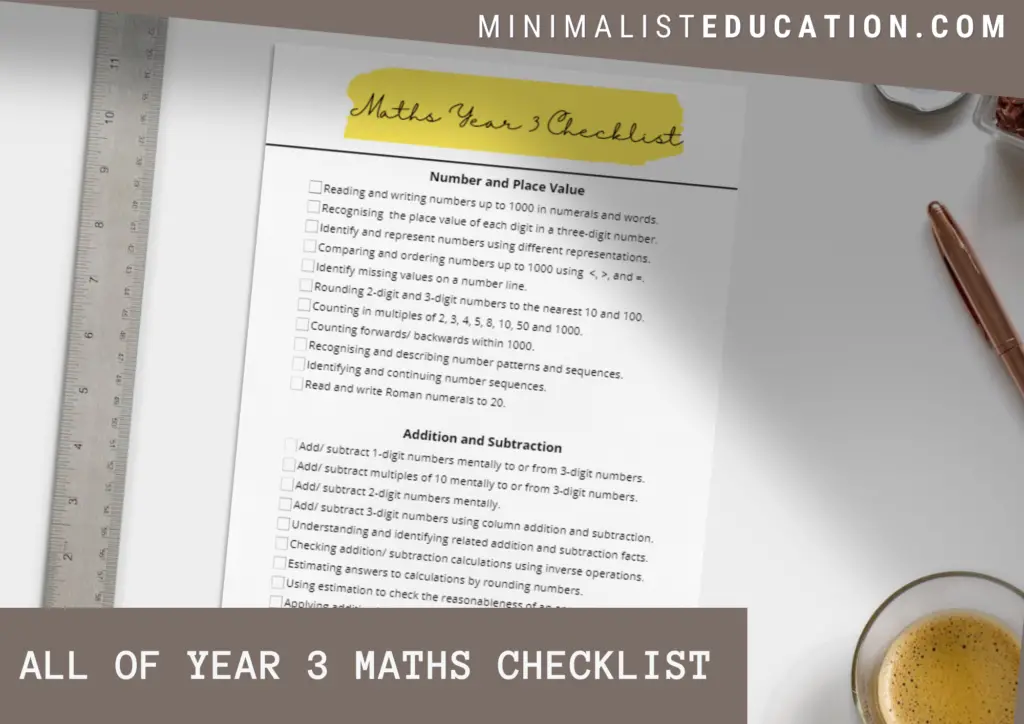
This year 3 maths checklist acts as a super useful overview and guide. You can use this to get an idea of the outcomes expected of children by the end of year 3 as set out in the National Curriculum.
Download the Check-list for Year 3 Maths:
Year 3 Number and Place Value Assessment
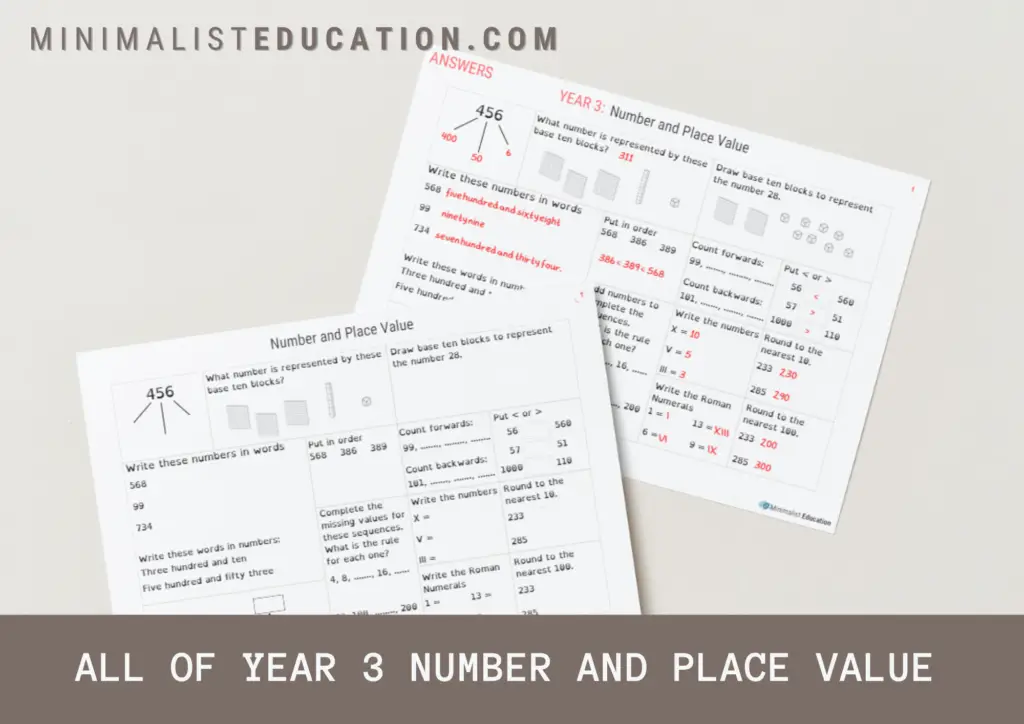
Download the Year 3 Quick-Check for Number and Place Value:
Based on the UK National Curriculum, the learning objectives that can be assessed using this Quick-Check number and place value for Year 3 maths include the following:
- Reading and writing numbers up to 1000 in numerals and words.
- Recognising the place value of each digit in a three-digit number.
- Identify, represent and estimate numbers using different representations.
- Comparing and ordering numbers up to 1000 using the symbols <, >, and =.
- Identify missing values on a number line.
- Rounding two-digit and three-digit numbers to the nearest 10 and 100.
- Counting in multiples of 2, 3, 4, 5, 8, 10, 50 and 1000.
- Counting forwards and backwards from any given number within 1000.
- Recognizing and describing number patterns and sequences, including counting in steps of different sizes.
- Identifying and continuing number sequences formed by counting on or back from a given number.
- Read and write Roman numerals to 20.
Year 3 Addition and Subtraction Assessment
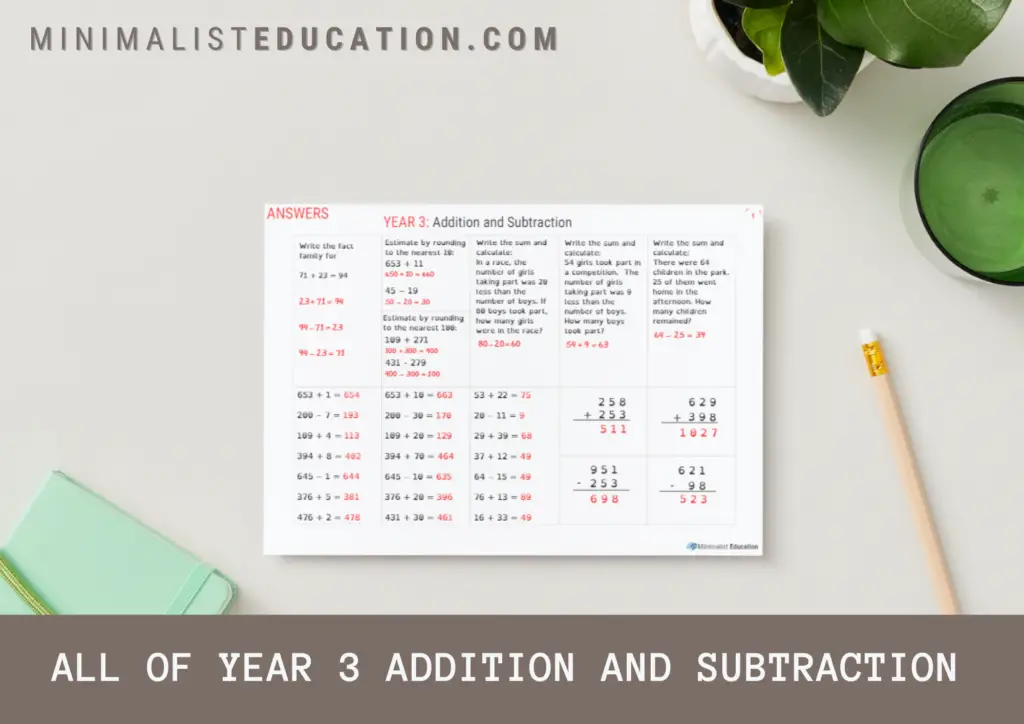
Download the Year 3 Quick-Check for Addition and Subtraction:
Based on the UK National Curriculum, the learning objectives that can be assessed using this Quick-Check for addition and subtraction in Year 3 maths include the following:
Mental calculations:
- Adding and subtracting one-digit numbers or multiples of 10 mentally to or from three-digit numbers.
- Adding and subtracting two-digit numbers mentally, e.g., 46 + 20, 79 – 30.
Written addition and subtraction:
- Adding and subtracting three-digit numbers using column addition and subtraction, including exchanging or borrowing.
Checking and inverse operations:
- Understanding and identifying related addition and subtraction facts, e.g., knowing that if 7 + 3 = 10, then 10 – 3 = 7.
- Checking addition and subtraction calculations using the inverse operation.
Estimation and rounding:
- Estimating the answer to a calculation by rounding numbers to the nearest 10 or 100.
- Using estimation to check the reasonableness of an answer.
Problem-solving:
- Applying addition and subtraction skills to solve real-life problems and mathematical puzzles.
- Identifying the operations required to solve a problem and selecting appropriate strategies.
Year 3 Multiplication and Division Assessment
Times table fluency and mastery practice resources:
Based on the UK National Curriculum, the learning objectives for multiplication and division in Year 3 maths include the following:
Times tables:
- Develop rapid recall of multiplication and division facts for the 2, 3, 4, 5, 8, and 10 times tables.
Multiplication:
- Multiply two-digit and one-digit numbers, e.g., 23 x 4.
- Solve problems involving multiplication using arrays, repeated addition, and known multiplication facts.
- Use the commutative law of multiplication (e.g., 3 x 4 = 4 x 3).
Division:
- Divide two-digit numbers by one-digit numbers, e.g., 56 ÷ 7.
Problem-solving:
- Apply multiplication and division skills to solve problems.
- Interpret and represent multiplication and division problems using diagrams, models, and equations.
Multiples and factors:
- Recognise and identify multiples and factors of a given number.
Year 3 Fractions Assessment
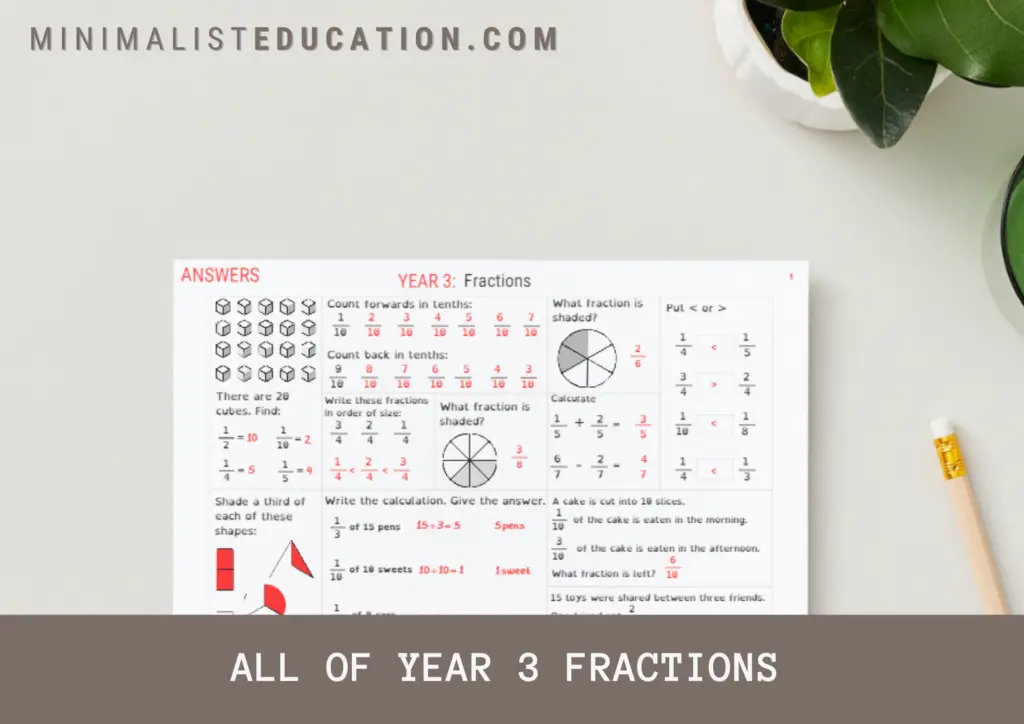
Download the Year 3 Quick-Check for Fractions:
Based on the UK National Curriculum, the learning objectives that can be assessed using this Quick-Check for fractions in Year 3 maths include the following:
Recognising and identifying fractions:
- Recognise, name, and write fractions of a whole and a set of objects.
- Count up and down in tenths.
Equivalent fractions:
- Recognise and show, using diagrams, equivalent fractions with small denominators.
Comparing fractions:
- Compare and order unit fractions, and fractions with the same denominators.
Calculating with fractions:
- Add and subtract fractions with the same denominator within one whole.
- Apply fraction skills to solve real-life problems and mathematical puzzles.
Year 3 Measurement Assessment

Download the Year 3 Quick-Check for Measurement:
Based on the UK National Curriculum, the learning objectives that can be assessed using this Quick-Check for measurements in Year 3 maths include the following:
Measuring length and height:
- Measure and compare the lengths and heights of objects using standard units (centimetre and meters).
- Estimate and measure lengths to the nearest centimetre or meter using rulers or other measuring tools.
- Solve problems involving addition and subtraction of lengths.
Measuring mass and weight:
- Measure and compare the mass and weight of objects using standard units (grams and kilograms).
- Estimate and measure masses to the nearest gram or kilogram using weighing scales or other measuring tools.
- Solve problems involving addition and subtraction of masses.
Measuring capacity and volume:
- Measure and compare the capacity and volume of containers using standard units (millilitres and litres).
- Estimate and measure capacities and volumes to the nearest millilitre or litre using measuring jugs or other measuring tools.
- Solve problems involving addition and subtraction of capacities.
Time:
- Tell and write the time using analogue and digital clocks, including both o’clock and half past.
- Use vocabulary related to time (e.g., seconds, minutes, hours, days, weeks, months, years).
- Read and interpret calendars, including days of the week and months of the year.
- Solve problems involving time durations and time intervals.
Money:
- Recognize and use different denominations of coins and notes.
- Add and subtract amounts of money using pounds and pence.
- Solve problems involving money, including giving change.
Converting units of measurement:
- Convert between different units of length, mass, and capacity using appropriate strategies.
Year 3 Geometry Assessment
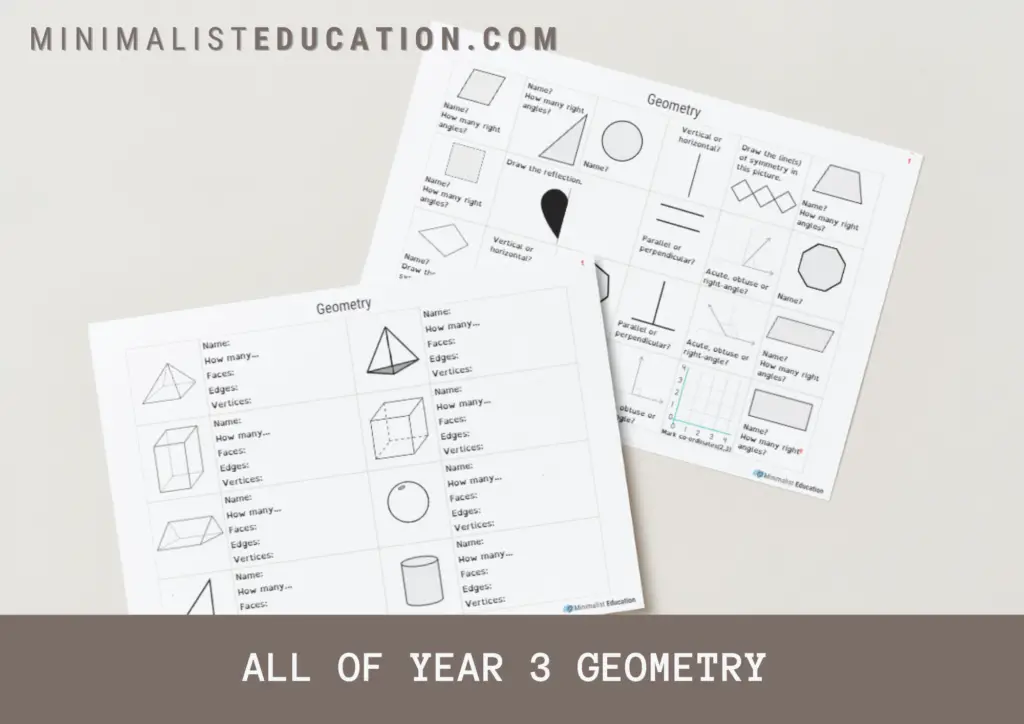
Download the Year 3 Quick-Check for Geometry:
Based on the UK National Curriculum, the learning objectives that can be assessed using this Quick-Check for geometry in Year 3 maths include the following:
Properties of shapes:
- Recognize and name common 2D shapes, including quadrilaterals: square, rectangle, circle, triangle, pentagon, hexagon, octagon, parallelogram, rhombus, trapezium
- Recognize and name common 3D shapes: cube, cuboid, sphere, cylinder, cone, pyramid
- Identify and describe the properties (sides, angles, faces) of 2D and 3D shapes.
Lines and angles:
- Recognise and identify horizontal, vertical, and diagonal lines.
- Recognise and identify pairs of parallel and perpendicular lines.
- Recognise and identify right angles in shapes and objects.
- Estimate and compare angles as larger or smaller than a right angle.
Symmetry:
- Identify and describe lines of symmetry in 2D shapes.
- Complete symmetrical patterns and shapes.
Position and direction:
- Describe the position of objects using mathematical language (e.g., above, below, left, right, between).
- Use coordinates to specify positions on a grid.
Year 3 Statistics Assessment
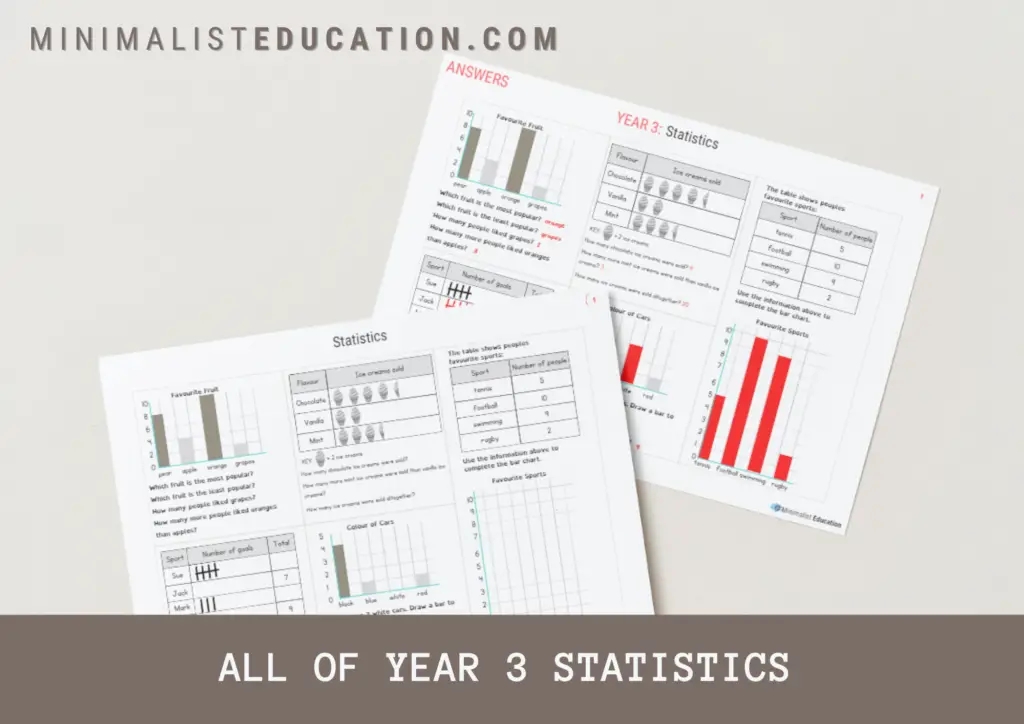
Download the Year 3 Quick-Check for Statistics:
Based on the UK National Curriculum, the learning objectives for statistics that can be assessed using this Quick-Check for statistics in Year 3 maths include the following:
- Present, read, interpret data using tally charts, frequency tables, bar charts and pictograms.
- Solve one-step and two step questions using information presented in charts and tables.
That’s it!
I hope you find these resources as useful as I do. While my own kids are beyond this stage of maths, I actually made these for me to use in the classroom. I have used these for many different reasons: to get my students to practice the content we covered in previous terms; to help me identify any gaps in their knowledge; to inform my planning as these Quick-Checks highlight any topics that I might need to go over again with the class.
I would love to know how you use these Quick-Check resources in your homeschool. Are there any other year groups that you would like to see resources made for? Let me know in the comments.
Very useful ressources , jazaki Allah khayr
Wa eeyaki,
So glad you have found them useful!